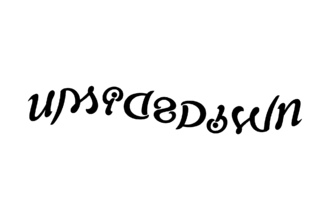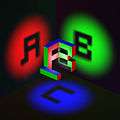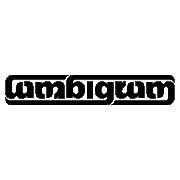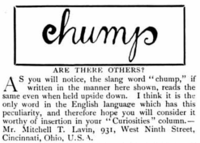Ambigram
An ambigram is a word, art form or other symbolic representation whose elements retain meaning when viewed or interpreted from a different direction, perspective, or orientation.
The meaning of the ambigram may either change, or remain the same, when viewed or interpreted from different perspectives.
Douglas R. Hofstadter describes an ambigram as a "calligraphic design that manages to squeeze two different readings into the selfsame set of curves." Different ambigram artists (sometimes called ambigramists) may create completely different ambigrams from the same word or words, differing in both style and form.
Discovery and popularity
The earliest known non-natural ambigram dates to 1893 by artist Peter Newell. Although better known for his children's books and illustrations for Mark Twain and Lewis Carroll, he published two books of invertible illustrations, in which the picture turns into a different image entirely when turned upside down. The last page in his book Topsys & Turvys contains the phrase THE END, which, when inverted, reads PUZZLE. In Topsys & Turvys Number 2 (1902), Newell ended with a variation on the ambigram in which THE END changes into PUZZLE 2.
The Verbeek strip "The UpsideDowns of old man Muffaroo and little lady Lovekins" used ambigrams in 3 consecutive strips in March,1904, but otherwise the format of this strip prevented the use of word balloons.
From June to September, 1908, the British monthly The Strand published a series of ambigrams by different people in its "Curiosities" column.[1] Of particular interest is the fact that all four of the people submitting ambigrams believed them to be a rare property of particular words. Mitchell T. Lavin, whose "chump" was published in June, wrote, "I think it is in the only word in the English language which has this peculiarity," while Clarence Williams wrote, about his "Bet" ambigram, "Possibly B is the only letter of the alphabet that will produce such an interesting anomaly."[1]
In 1969, Raymond Loewy designed the rotational NEW MAN ambigram logo, which is still in use today.[2][3] The mirror ambigram DeLorean Motor Company logo was first used in 1975.[4][5]
John Langdon and Scott Kim also each believed that they had invented ambigrams in the 1970s.[6] Langdon and Kim are probably the two artists who have been most responsible for the popularization of ambigrams. John Langdon produced the first mirror image logo "Starship" in 1975.[7] Robert Petrick, who designed the invertible Angel logo in 1976, was also an early influence on ambigrams.[8]
The earliest known published reference to the term ambigram was by Hofstadter, who attributed the origin of the word to conversations among a small group of friends during 1983–1984.[9] The original 1979 edition of Hofstadter's Gödel, Escher, Bach featured two 3-D ambigrams on the cover.
Ambigrams became more popular as a result of Dan Brown incorporating John Langdon's designs into the plot of his bestseller, Angels & Demons, and the DVD release of the Angels & Demons movie contains a bonus chapter called "This is an Ambigram". Langdon also produced the ambigram that was used for some versions of the book's cover.[6] Brown used the name Robert Langdon for the hero in his novels as an homage to John Langdon.[10]
In music, the Grateful Dead have used ambigrams several times, including on their albums Aoxomoxoa and American Beauty.
In the first series of the British show Trick or Treat, the show's host and creator Derren Brown uses cards with rotational ambigrams. These cards can read either 'Trick' or 'Treat'.
Although the words spelled by most ambigrams are relatively short in length, one DVD cover for The Princess Bride movie creates a rotational ambigram out of two words: "Princess Bride," whether viewed right side up or upside down.[11]
The Transformers movie series have logos that are a robot face whether viewed right side up or upside down. There are two such logos, one for an Autobot, and one for a Decepticon.[12][13]
In 2015 iSmart's logo on one of its travel chargers went viral because upside-down it read "+Jews!" The company noted that "...we learned a powerful lesson of what not to do when creating a logo.” [14]
Types

Ambigrams are exercises in graphic design that play with optical illusions, symmetry and visual perception. Some ambigrams feature a relationship between their form and their content. Ambigrams usually fall into one of several categories:
- 3-Dimensional
- A design where an object is presented that will appear to read several letters or words when viewed from different angles. Such designs can be generated using constructive solid geometry.
- Chain
- A design where a word (or sometimes words) are interlinked, forming a repeating chain. Letters are usually overlapped meaning that a word will start partway through another word. Sometimes chain ambigrams are presented in the form of a circle.
- Dihedral
- A natural mirror-image ambigram consisting of numerical digits.
- Figure-ground
- A design in which the spaces between the letters of one word form another word.
- Fractal
- A version of space-filling ambigrams where the tiled word branches from itself and then shrinks in a self-similar manner, forming a fractal. See Scott Kim's fractal of the word "TREE" for an animated example.[15]
- Mirror-image
- A design that can be read when reflected in a mirror, usually as the same word or phrase both ways. Ambigrams that form different words when viewed in the mirror are also known as glass door ambigrams, because they can be printed on a glass door to be read differently when entering or exiting.
- Multi-Lingual
- An ambigram that can be read one way in one language and another way in a different language. Multi-lingual ambigrams can exist in all of the various styles of ambigrams, with multi-lingual perceptual shift ambigrams being particularly striking.
- Natural
- A natural ambigram is a word that possesses one or more of the above symmetries when written in its natural state, requiring no typographic styling. For example, the words "dollop", "suns" and "pod" form natural rotational ambigrams. In Korean, 곰 (bear) and 문 (door) form a natural rotational ambigram. In some fonts, the word "swims" forms a natural rotational ambigram. The word "bud" forms a natural mirror ambigram when reflected over a vertical axis. The words "CHOICE" and "OXIDE", in all capitals, form natural mirror ambigrams when reflected over a horizontal axis. The longest such word is CHECKBOOK. The word "TOOTH", in all capitals, forms a natural mirror ambigram when its letters are stacked vertically and reflected over a vertical axis. See the article transformation of text for a discussion of letter symmetry.
- Perceptual Shift (Oscillation)
- A design with no symmetry but can be read as two different words depending on how the curves of the letters are interpreted.
- Rotational
- A design that presents several instances of words when rotated through a fixed angle. This is usually 180 degrees, but rotational ambigrams of other angles exist, for example 90 or 45 degrees. The word spelled out from the alternative direction(s) is often the same, but may be a different word to the initially presented form. A simple example is the lower-case abbreviation for "Down", dn, which looks like the lower-case word up when rotated 180 degrees.
- Strobogrammatic
- A natural rotational ambigram consisting of numerical digits.
- Space-Filling
- Similar to chain ambigrams, but tile to fill the 2-dimensional plane.
- Spinonym
- An ambigram in which all the letters are made of the same glyph, possibly rotated and/or inverted. WEB is an example of a word that can easily be made into a spinonym. Previously called rotoglyphs or rotaglyphs.[16]
- Symbiotogram
- An ambigram that, when rotated, can be read as a different word than the original, e.g., "LIFE" would read as "DEATH". [17]
-

Rotational ambigram, Vegas
-

Mirror-image ambigram, Wiki
-

Three-dimensional ambigram, ABC
-

Perceptual shift ambigram, Wave and Particle
-
Spinonym, neun (German for nine)
Creating ambigrams
There are no universal guidelines for creating ambigrams, and there are different ways of approaching problems. A number of books suggest methods for creation (including WordPlay[18] and Eye Twisters[19]).
Computerized methods to automatically create ambigrams have been developed. The earliest, the 'Ambimatic' created in 1996,[20] was letter-based and used a database of 351 letter glyphs in which each letter was mapped to another.[21] This generator could only map a word to itself or to another word that was the same length: because of this, most of the generated ambigrams were of poor quality.[21] However, the Ambimatic has been almost completely taken down (it was available on Ambigram.com, but they deleted that site and it is now a redirect to FlipScript.com), it's only available as an app for Android. In 2007, software developer Mark Hunter developed the ambigram generator at FlipScript.com (and licensed to other companies).[20] It uses a more complex method of creating ambigrams,[22] with a database containing more than 5 million curves,[23] and multiple lettering styles.
Other names
Ambigrams have also been called, among other things:
- vertical palindromes (1965)[24]
- designatures (1979)[25]
- inversions (1980)[26]
See also
- Anagram
- Gödel, Escher, Bach by Douglas Hofstadter
- Mirror writing
- Palindrome
- Strobogrammatic number
- Gustave Verbeek
References
- 1 2 Newnes, George (1908). "Curiosities". The Strand Magazine. No. 36. p. 359. Retrieved 6 November 2016.
- ↑ "Raymond Loewy Biographie". Raymond-loewy.un-jour.org (in French). Archived from the original on 8 June 2009. Retrieved 6 November 2016.
- ↑ Pierce, Scott (20 May 2009). "Typography Two Ways: Calligraphy With a Twist". Wired (website). Wired.com. Retrieved 6 November 2016.
- ↑ "1975 Prototype Logo". Car and Driver. July 1977. Retrieved 6 November 2016. In 1977, only the single 1975 prototype existed. Note that there are multiple visible differences between the prototype vehicle and later production models, including the design of the front end.
- ↑ "Motor City eyebrows were raised when DeLorean married model Cristina Ferrare.". US Magazine. 1 November 1977. Retrieved 6 November 2016.
- 1 2 Bearn, Emily (4 December 2005). "The Doodle Bug". The Telegraph. Retrieved 6 November 2016.
- ↑ Langdon, John. "Starship". johnlangdon.net. John Langdon. Retrieved 6 November 2016.
- ↑ "Angel Logo". angelrocks.com. 2 October 2009. Retrieved 6 November 2016.
- ↑ Hofstadter, Douglas. "Origins of the word Ambigram" (e-mail message to David Holst). Retrieved 6 November 2016.
- ↑ Brown, Dan (21 December 2005). "As a tribute to John Langdon, I named the protagonist Robert Langdon.". Popularculture.it (in Italian). Retrieved 6 November 2016.
- ↑ "The Princess Bride (20th Anniversary Widescreen Edition) (Bilingual)". amazon.ca. Amazon.com. Retrieved 6 November 2016.
- ↑ "TRANSFORMER ambigram". Society6.com. Society6. Retrieved 6 November 2016.
- ↑ "Transformers Decepticon Decal". Amazon.com. Amazon. Retrieved 6 November 2006.
- ↑ Hoffman, Jenn (9 May 2015). "This Charger that Says 'Jews' Is Today's Tech Fail". motherboard.com. Vice (magazine). Retrieved 6 November 2016.
- ↑ Kim, Scott (1981). "Tree". scottkim.com. Retrieved 6 November 2016.
- ↑ See Hofstadter, Ambigrammi, p. 48.
- ↑ Prokhorov, Nikita (2013). Ambigrams Revealed: A Graphic Designer's Guide To Creating Typographic Art Using Optical Illusions, Symmetry, and Visual Perception. New Riders. pp. 51, 124. ISBN 9780133086461.
- ↑ Langdon, John. WordPlay. Bantam Press. ISBN 0-593-05569-1.
- ↑ Polster, Burkard. Eye Twisters. Constable. ISBN 1-84529-629-X.
- 1 2 Holst, David. "Ambigram.com". ambigram.com. Word.Net Communications. Archived from the original on 3 February 2006. Retrieved 6 November 2016.
- 1 2 Polster, Burkard. Eye Twisters. Constable. pp. 174–176. ISBN 1-84529-629-X.
- ↑ "The Ambigram Generator". flipscript.com. Archived from the original on 13 January 2014. Retrieved 6 November 2016.
- ↑ "Ambigram Generator, Part 2". flipscript.com. Archived from the original on 22 December 2013. Retrieved 6 November 2016.
- ↑ Borgmann, Dmitri (1965). Language on Vacation: An Olio of Orthographical Oddities. Scribner. p. 27. ASIN B0007FH4IE.
- ↑ OMNI magazine, September 1979, page 143, work of Scott Kim.
- ↑ Kim, Scott (1980). Inversions: Catalogue of Calligraphic Cartwheels. McGraw-Hill Inc., US. ISBN 0-07-034546-5.
Further reading
- Borgmann, Dmitri A., Language on Vacation: An Olio of Orthographical Oddities, Charles Scribner's Sons (1965)
- Kim, Scott, Inversions: A Catalog of Calligraphic Cartwheels, Byte Books (1981, republished 1996)
- Hofstadter, Douglas R., "Metafont, Metamathematics, and Metaphysics: Comments on Donald Knuth's Article 'The Concept of a Meta-Font'" Scientific American (August 1982) (republished, with a postscript, as chapter 13 in the book Metamagical Themas)
- Langdon, John, Wordplay: Ambigrams and Reflections on the Art of Ambigrams, Harcourt Brace (1992, republished 2005)
- Hofstadter, Douglas R., Ambigrammi: Un microcosmo ideale per lo studio della creativita (Ambigrams: An Ideal Microworld for the Study of Creativity), Hopefulmonster Editore Firenze (1987) (in Italian)
- Polster, Burkard, Les Ambigrammes l'art de symétriser les mots, Editions Ecritextes (2003) (French)
- Polster, Burkard, Eye Twisters: Ambigrams, Escher, and Illusions (2007)
- Polster, Burkard, Eye Twisters: Ambigrams & Other Visual Puzzles to Amaze and Entertain, Constable (2007)
- Prokhorov, Nikita, Ambigrams Revealed: A Graphic Designer's Guide To Creating Typographic Art Using Optical Illusions, Symmetry, and Visual Perception New Riders (2013)


